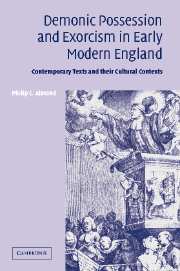 Demonic Possession and Exorcism in Early Modern England
Demonic Possession and Exorcism in Early Modern England Book contents
- Frontmatter
- Contents
- Preface
- Introduction
- Chapter 1 Disfigured by the Devil: The story of Alexander Nyndge
- Chapter 2 Two possessed maidens in London: The story of Agnes Briggs and Rachel Pinder
- Chapter 3 The witches of Warboys: The story of the Throckmorton children
- Chapter 4 The boy of Burton: The story of Thomas Darling
- Chapter 5 A household possessed: The story of the Lancashire seven
- Chapter 6 The counterfeit demoniac: The story of William Sommers
- Chapter 7 The puritan martyr: The story of Mary Glover
- Chapter 8 The boy of Bilson: The story of William Perry
- Chapter 9 A pious daughter: The story of Margaret Muschamp
- References
- Index
Chapter 9 - A pious daughter: The story of Margaret Muschamp
Published online by Cambridge University Press: 22 September 2009
- Frontmatter
- Contents
- Preface
- Introduction
- Chapter 1 Disfigured by the Devil: The story of Alexander Nyndge
- Chapter 2 Two possessed maidens in London: The story of Agnes Briggs and Rachel Pinder
- Chapter 3 The witches of Warboys: The story of the Throckmorton children
- Chapter 4 The boy of Burton: The story of Thomas Darling
- Chapter 5 A household possessed: The story of the Lancashire seven
- Chapter 6 The counterfeit demoniac: The story of William Sommers
- Chapter 7 The puritan martyr: The story of Mary Glover
- Chapter 8 The boy of Bilson: The story of William Perry
- Chapter 9 A pious daughter: The story of Margaret Muschamp
- References
- Index
Summary
In Wonderful News from the North, Mary Moore tells the story of the bewitchment of her eleven-year-old daughter Margaret Muschamp, and of her eventual deliverance, the bewitchment of two others, her daughter Betty and son George, and the death of a fourth child, her infant daughter Sibilla. In this sense it is unique. For it is the only story of possession we have in which the authorship is attributable to a woman. It was written by Mary Moore to encourage the legal pursuit of the woman whom she believed was responsible for the misfortunes which befell her family, namely Dorothy Swinow. The story is driven by Mary's frustration at not being able to persuade anybody, including her own husband, of the guilt of Dorothy, and punctuated by Mary's ‘shopping’ for a sympathetic judge. It ends with the indictment of Swinow, but there is no suggestion within the text nor any evidence elsewhere that anything further came of it.
The authorship itself is not clear. The Preface to the Reader is signed by Mary Moore. The text speaks on occasion in the first person. But more often Mary is written of in the third person as the mother of the afflicted. The fragmentary and contradictory nature of the text is best explained if we see it more as a collection of texts, written by a number of persons including Mary, and put together by her.
- Type
- Chapter
- Information
- Demonic Possession and Exorcism in Early Modern EnglandContemporary Texts and their Cultural Contexts, pp. 358 - 390Publisher: Cambridge University PressPrint publication year: 2004


